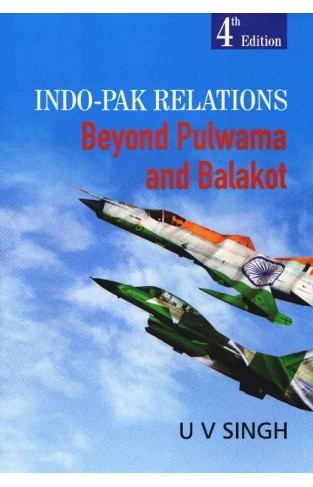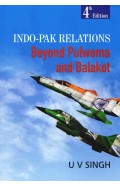- Home
- Books
- Categories
- Non Fiction
- Politics & Current Affairs
- Indo-Pak Relations : Beyond Pulwama and Balakot
Indo-Pak Relations : Beyond Pulwama and Balakot
By: U.V. Singh
-
Rs 4,871.75
- Rs 7,495.00
- 35%
You save Rs 2,623.25.
Due to constant currency fluctuation, prices are subject to change with or without notice.
This book deals with the fundamental causes of the Indo-Pak conflict—why it is difficult, if not impossible, to have peace between the two neighbors. Also it explores the short spurt of Pulwama-Balakot stand-off or a game of one-upmanship. It analyses the perennial conflict scenario and goes to stress that for Pakistan, in recent times, there has been no marked change in disincentives (negative stresses) that could compel it to moderate its behavior towards India—and nor there exists a package of incentives (positive stresses) that should force it to go for a change towards peace. All the key stakeholders of Pakistan (including army, ISI and terror outfits), other than the Pak public, will stand to lose if the religion-steeped state turned friendly, or even nonaggressive, towards India. In that situation, it is indeed difficult to comprehend for a logical mind that why should Indian politicians and diplomats hanker for the illusionary scenario of peace to unfold. Let it be clear for one and all that peace (or even normalcy) between India and Pakistan will only be possible under one of the following situations. That’ incentives’ package (positive stresses) for Pakistan in the event of being friendly is so great that the same can’t be resisted. Or, the disincentives for retaining its historical behavior towards India are so great that the same can’t be resisted by its army-and ISI combine. As long as one of the above two conditions doesn’t materialize, or isn’t forced upon, it shall remain just foolhardy for India to expect that things between the two quarrelsome neighbors shall turn towards normalcy.
This book deals with the fundamental causes of the Indo-Pak conflict—why it is difficult, if not impossible, to have peace between the two neighbors. Also it explores the short spurt of Pulwama-Balakot stand-off or a game of one-upmanship. It analyses the perennial conflict scenario and goes to stress that for Pakistan, in recent times, there has been no marked change in disincentives (negative stresses) that could compel it to moderate its behavior towards India—and nor there exists a package of incentives (positive stresses) that should force it to go for a change towards peace. All the key stakeholders of Pakistan (including army, ISI and terror outfits), other than the Pak public, will stand to lose if the religion-steeped state turned friendly, or even nonaggressive, towards India. In that situation, it is indeed difficult to comprehend for a logical mind that why should Indian politicians and diplomats hanker for the illusionary scenario of peace to unfold. Let it be clear for one and all that peace (or even normalcy) between India and Pakistan will only be possible under one of the following situations. That’ incentives’ package (positive stresses) for Pakistan in the event of being friendly is so great that the same can’t be resisted. Or, the disincentives for retaining its historical behavior towards India are so great that the same can’t be resisted by its army-and ISI combine. As long as one of the above two conditions doesn’t materialize, or isn’t forced upon, it shall remain just foolhardy for India to expect that things between the two quarrelsome neighbors shall turn towards normalcy.
Indo-Pak Relations: Glamour, Drama or Diplomacy
By: U.V. Singh
Rs 900.00 Rs 1,000.00 Ex Tax :Rs 900.00
Indo-Pak Relations : Beyond Pulwama and Balakot
By: U.V. Singh
Rs 4,871.75 Rs 7,495.00 Ex Tax :Rs 4,871.75
Zubin Mehta: A Musical Journey (An Authorized Biography)
By: VOID - Bakhtiar K. Dadabhoy
Rs 472.50 Rs 1,050.00 Ex Tax :Rs 472.50
Manning Up: How the Rise of Women Has Turned Men into Boys
By: Kay Hymowitz
Rs 646.75 Rs 995.00 Ex Tax :Rs 646.75
No recently viewed books available at the moment.
Zubin Mehta: A Musical Journey (An Authorized Biography)
By: VOID - Bakhtiar K. Dadabhoy
Rs 472.50 Rs 1,050.00 Ex Tax :Rs 472.50
Indo-Pak Relations: Glamour, Drama or Diplomacy
By: U.V. Singh
Rs 900.00 Rs 1,000.00 Ex Tax :Rs 900.00
Indo-Pak Relations : Beyond Pulwama and Balakot
By: U.V. Singh
Rs 4,871.75 Rs 7,495.00 Ex Tax :Rs 4,871.75















-120x187.jpg?q6)





-120x187.jpg?q6)









